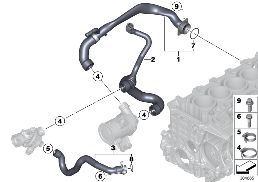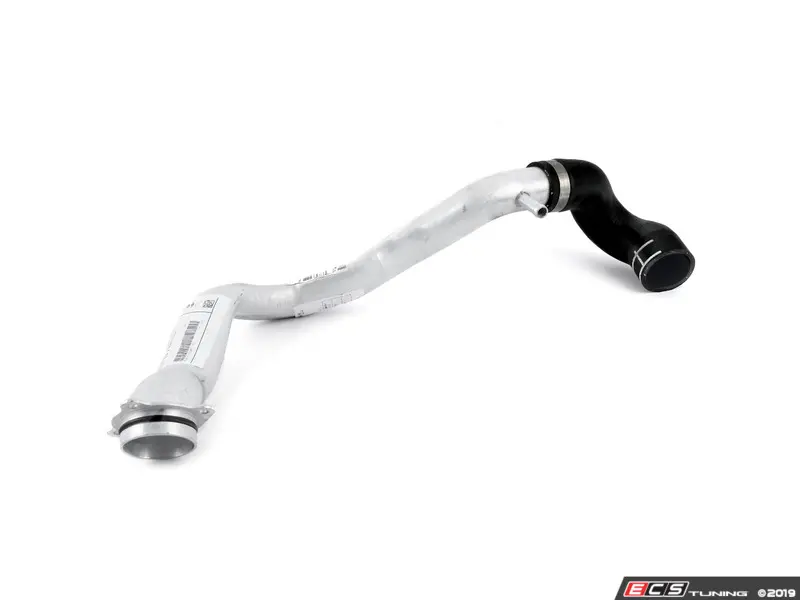You are using an out of date browser. It may not display this or other websites correctly.
You should upgrade or use an alternative browser.
You should upgrade or use an alternative browser.
Coolant hose replacement.
- Thread starter BMWTurboDzl
- Start date
"...replace all the hoses.." On mine, there are many (30?) hoses. Three radiators in the front and engine in the back. Many are tiny that connect metal pipes. Scratch my head why the pipes are not just a single piece. That's the "german" engineering approach to things- needless complication. Any time I go on a trip, I wonder about them rupturing. OE hoses will break the bank.My thoughts - 2 almost the same vehicles, 3 years apart, one with 300K and one with 100K
-- mileage doesn't seem to matter
-- If you have a 10 year old car and want to keep it another 10, you might as well replace all the hoses because you likely will have a leak at some point. While flexible - it was obvious they had aged a lot. The exterior was hard. You could leave a finger nail impression on the new ones that you couldn't with the old one. If you have a 10 year old beater you want to keep 3 more years - I would just leave it.
10 years/100,000 miles - carefully examine everything whether it moves or not. My experience is that other issues will usually take a vehicle off the road before the hoses fail. Talking about vehicles produced in the late 80's and later.
I was wondering why that was happening....When you start seeing rubberized black powder accumulating in your overflow tank, then it's time to change the hoses.
When you start seeing rubberized black powder accumulating in your overflow tank, then it's time to change the hoses.
When you saw that, did you do anything about it, maybe post an inquiry about what you were seeing, or did you just wonder?I was wondering why that was happening....
BMWTurboDzl
Thread starter
I think the metal/rubber hoses are due to heat. My vehicle has a hose like this (see #1 in diagram). The metal end is attached to the back end of the I6 block and travels to the front passing the turbocharger/exhaust manifold. The rubber portion is attached to the electric water pump. As you can the rubber piece is attached with a crimped metal band. I don't think the rubber portion can be bought individually. The piece runs about $150. The hose I was going to replace (See #3 in diagram) runs about $50 from the dealer and has the same crimped metal band but it has an thermoplastic flange attached. I may just do all three hoses as they're all 8 yrs old."...replace all the hoses.." On mine, there are many (30?) hoses. Three radiators in the front and engine in the back. Many are tiny that connect metal pipes. Scratch my head why the pipes are not just a single piece. That's the "german" engineering approach to things- needless complication. Any time I go on a trip, I wonder about them rupturing. OE hoses will break the bank.
EDIT: Rein sells a rubber replacement piece for the rubber portion of the metal hose so I guess people remove the entire hose, replace the gasket, and cut off the rubber portion. *shrug*


Last edited:
I'm still just wondering. My intent is to flush the cooling system at some point (meaning multiple drain and refills with water until it comes out clean) and refill with new stuff, probably Peak 10X. Car in question is a 2000 Camry. Coolant hoses are all original and look perfectly fine. Perhaps I should take a picture of what I am seeing and post it here. I have no idea what the "dirt" on the cooling reservoir is, but tiny hose particles certainly sounds like a possibility.When you start seeing rubberized black powder accumulating in your overflow tank, then it's time to change the hoses.
When you saw that, did you do anything about it, maybe post an inquiry about what you were seeing, or did you just wonder?
Toyota has a problem with rubber hoses on some 6-cylinder engines, and they came out with an updated part. This clip shows the situation.I think the metal/rubber hoses are due to heat. My vehicle has a hose like this (see #1 in diagram). The metal end is attached to the back end of the I6 block and travels to the front passing the turbocharger/exhaust manifold. The rubber portion is attached to the electric water pump. As you can the rubber piece is attached with a crimped metal band. I don't think the rubber portion can be bought individually. The piece runs about $150. The hose I was going to replace (See #3 in diagram) runs about $50 from the dealer and has the same crimped metal band but it has an thermoplastic flange attached. I may just do all three hoses as they're all 8 yrs old.


Why flush? was the wrong coolant used?I'm still just wondering. My intent is to flush the cooling system at some point (meaning multiple drain and refills with water until it comes out clean) and refill with new stuff, probably Peak 10X. Car in question is a 2000 Camry. Coolant hoses are all original and look perfectly fine. Perhaps I should take a picture of what I am seeing and post it here. I have no idea what the "dirt" on the cooling reservoir is, but tiny hose particles certainly sounds like a possibility.
Before I got my 99, a shop used what i assume was all makes all models stuff after a t stat change. I swapped for Toyota red when I did the TB. Not sure I have touched since then. Not sure why I would. Drain and refill when I do the next TB.
Original hoses. But the rad was swapped, the fiberglass tanks were seeping. Keep an eye out for that.
Why flush? was the wrong coolant used?
Before I got my 99, a shop used what i assume was all makes all models stuff after a t stat change. I swapped for Toyota red when I did the TB. Not sure I have touched since then. Not sure why I would. Drain and refill when I do the next TB.
Original hoses. But the rad was swapped, the fiberglass tanks were seeping. Keep an eye out for that.
It still has some of it's original coolant, hence the flush. Radiator already replaced due to infamous Toyota upper plastic tank park break.
My Club Sport will be 28 years old in November, and has 150k miles on the clock. The only cooling system parts I have replaced are the thermostat and a plastic heater hose fitting. In 2021 I drove it to Hilton Head with the M42 motor spinning at 4000 rpm or higher for hours on end.
Yes, I know I'm living on borrowed time.
Yes, I know I'm living on borrowed time.
I was in the process of back flushing the heater hoses when in the process, I happen to stick my figure inside one of the hoses and discovered a black residue all over my finger. I thought hmm, that looks like the same stuff that's in the overflow tank. That's when the lightbulb went off in my head.I was wondering why that was happening....
"Y flush?"
answ:
as a routeen engine maintence proceedure. Read owners manual or side of collant container.
Life span of the product is less than 5 yrs. The stuff breaks down (anti corrosive, heat drop
additives, etc). Clean it all out, dont leave some in, and start anew~
My big trouble is where to get rid of it. I dont have enuff for the commercial pick up, too much to drop off @
the big bx stores (75 gal on site). I WILL NOT "just get rid of it". May B pour it into 1gal containers take to prts
houses when they dont deliver prts quick enuff? aahahahaa
answ:
as a routeen engine maintence proceedure. Read owners manual or side of collant container.
Life span of the product is less than 5 yrs. The stuff breaks down (anti corrosive, heat drop
additives, etc). Clean it all out, dont leave some in, and start anew~
My big trouble is where to get rid of it. I dont have enuff for the commercial pick up, too much to drop off @
the big bx stores (75 gal on site). I WILL NOT "just get rid of it". May B pour it into 1gal containers take to prts
houses when they dont deliver prts quick enuff? aahahahaa
- Joined
- Nov 28, 2020
- Messages
- 58
When I did replaced the hoses on my 1994 GM P-30 chassis RV (454 TBI w/4L80E) the hoses were original dated on the hose (10/93). Once I had them off I looked them over very closely. I could find no obvious signs of cracking anywhere. This was back in May 2018.
Most places allow you to dispose of coolant in the sanitary sewer system.My big trouble is where to get rid of it.
not sure what that is but if it gets into water it's a no, no (poison).Most places allow you to dispose of coolant in the sanitary sewer system.
The ground water, City treatment plant, 'ground' water (streams etc), man hole cover...
recycle it properly at acceptance centers or the truck comes to my shop to trade it off for new...
I don't think so. Try that around here and your butt will be hauled away before you can say "But zrxkawboy said it was OK." I sure hope you're not doing that with your used coolant.Most places allow you to dispose of coolant in the sanitary sewer system.
I don’t know where “around here” is, but you’re in the minority. It is allowed most places. Or are you just taking a wag that “your butt will be hauled away”?I don't think so. Try that around here and your butt will be hauled away before you can say "But zrxkawboy said it was OK." I sure hope you're not doing that with your used coolant.
Here’s another thread with references, including the OH EPA.
https://bobistheoilguy.com/forums/threads/coolant-antifreeze-recycling-disposal.290998/
Here’s a couple more states as examples that will not haul your butt away:I don't think so. Try that around here and your butt will be hauled away before you can say "But zrxkawboy said it was OK." I sure hope you're not doing that with your used coolant.
http://www.deq.state.ne.us/Publica....23ae62a1265ed84e862577bc0058a45d?OpenDocument
https://dnr.mo.gov/document-search/antifreeze-waste-management-guide-pub0114/pub0114
Again, these are just a couple examples. A quick search will lead you to more.
Similar threads
- Replies
- 8
- Views
- 289
- Replies
- 1
- Views
- 262
- Replies
- 33
- Views
- 794
- Replies
- 21
- Views
- 2K
